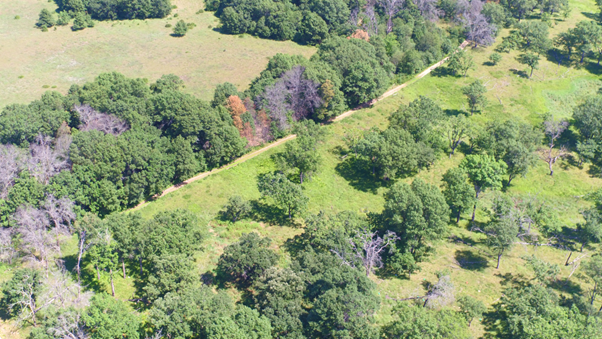[ad_1]
Emma Ladouceur & Jonathan M. Chase discuss their recent article: The recovery of plant community composition following passive restoration across spatial scales. Find out more about what it takes for ecosystems to recover from disturbances and whether passive restoration is enough.
Human disturbances can negatively impact species, biodiversity and ecosystems. Given enough time, will ecosystems recover on their own? And, how do they recover?
It is well-known that the recovery of ecosystems can be slow, and recovery can be incomplete. However, our ability to detect recovery depends on our ability to monitor change across long time-scales, and our inferences depend on the spatial scale at which we measure recovering systems. These inferences can tell us how systems are recovering from various angles, and perhaps give us better insight into the complexity of the whole picture.
The Cedar Creek Ecosystem Science Reserve just north of Minneapolis, Minnesota and a part of the University of Minnesota, is probably one of the most well-known field stations in the world. Research at Cedar Creek has played a central role in the development of modern ecology, from some of the earliest work on food webs and ecosystems by Ray Lindeman to the establishment and development of cutting-edge research on the role of biodiversity in the functioning of ecosystems that remains at the forefront of the field today. In the late 1970s, the Cedar Creek field station became one of the first sites of the budding U.S. Long Term Ecological Research (LTER) sites, allowing them to collect, curate and make openly available an invaluable set of data resources. The LTER infrastructure allowed researchers at Cedar Creek to monitor recovering grassland sites following the cessation of agriculture, as well as nearby savannahs that had never been ploughed for agriculture as reference sites. Taken together, data from these recovering fields now form a chronosequence of 80 years of recovery.
Our work in this paper builds on Isbell et al. 2019, who focussed primarily on how small-scale species richness (i.e., in 0.3 m2 plots) and productivity recovered (or more accurately did not recover) across a century of recovery since agricultural abandonment. We wondered whether these results scaled-up to larger spatial scales – where species rarity, habitat heterogeneity and other regional processes also played a role in determining patterns of species diversity. To do so, we needed to use a different set of sample plots from Cedar Creek that contained more samples, allowing us to investigate the recovery of these communities across scales, across many different fields. At the small scale (0.5 m2 plots), sometimes called alpha-diversity, our patterns mirrored those found in Isbell et al.; local plots recovered to somewhere between 70-75% of that found in the never-ploughed reference sites after 80-100 years. This shows consistent patterns across plot, fields and experiments between our study and Isbell et al. However, by examining patterns of recovery at larger spatial scales, we could address whether these recovery patterns were more predominantly due to changing relative abundances of the species, or due to dispersal limitation or other factors that preclude some species from recolonizing the sites.

Three general lessons can be drawn from the results of our study. First, somewhat to our surprise, we found that at the larger regional scale, sometimes referred to as gamma diversity, species richness also recovered to about 75% after 80 years. Furthermore, -beta-diversity, which indicates compositional differences among sites (measured here as (gamma/alpha) also recovered to about 90% of the reference sites. This means the composition of local communities must be changing through time as well. To investigate this, we took a checklist approach; we compared the checklist of species present in every recovering field to the checklist of all species present across all of the reference (never-ploughed) sites. Second, we learned that old fields were colonized by species that were not seen in the never-ploughed reference sites in the first years of recovery, but eventually species more characteristic of never-ploughed reference sites recolonized. Finally, we learned that introduced grasses dominate recovering communities at levels not seen in never-ploughed fields. While our results may be specific to the sites we studied, and different patterns of recovery at the alpha, beta and gamma scales in other systems, our overall approach examining how disturbance affects recovery across spatial scales can be an informative approach to understand the ecology of change.
So, can we learn how to better actively restore ecosystems recovering from disturbance by understanding these scale-dependent patterns and understanding recovery from different angles? For example, should we be seeding specific species that are missing from the recovering species pool, and should we consider seeding species in a spatially explicit way (e.g., seeding species in a patchy way)? Can we increase this seeding success or accelerate recovery by intervening at specific times during the recovery trajectory? Can we increase natural recovery success, or seeding success through periodic control of introduced grasses? We are currently investigating these questions using an extensive and growing database synthesising data from actively restored systems. You can get in touch with us if you have data you think might be suitable for asking these questions. Stay tuned.
Emma Ladouceur & Jonathan M. Chase The German Centre for Integrative Biodiversity Research (iDiv), Germany
Read the full article online: The recovery of plant community composition following passive restoration across spatial scales.
You can also read the press release for this paper here.
[ad_2]
Source link
